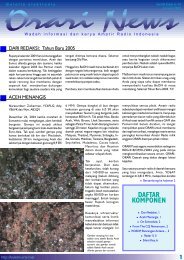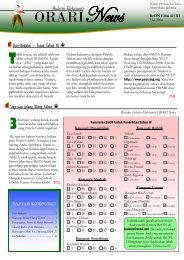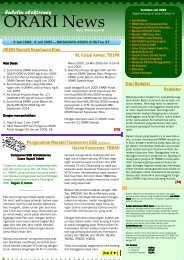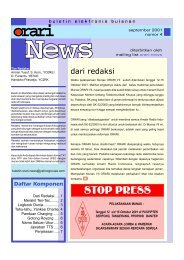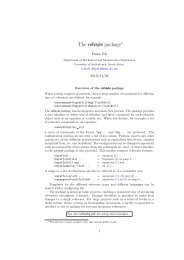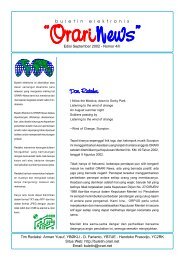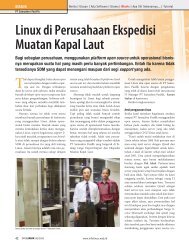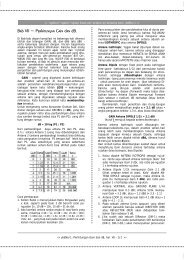The bicaption package - Kambing UI
The bicaption package - Kambing UI
The bicaption package - Kambing UI
You also want an ePaper? Increase the reach of your titles
YUMPU automatically turns print PDFs into web optimized ePapers that Google loves.
\captionmainlanguage<br />
\selectcaptionlanguage<br />
7 Language Selection<br />
For language selection the <strong>bicaption</strong> <strong>package</strong> uses two macros internally:<br />
\captionmainlanguage contains the main language, e.g. english or german.<br />
If not set prior to loading the <strong>bicaption</strong> <strong>package</strong>, the <strong>bicaption</strong> <strong>package</strong> will try to obtain<br />
this setting from the babel or polyglossia <strong>package</strong>.<br />
So if you are using either babel or polyglossia, and want to adopt the main language<br />
setting from it, then just load the <strong>bicaption</strong> <strong>package</strong> after it, and simply forget about the<br />
\captionmainlanguage stuff.<br />
Otherwise one can either define \captionmainlanguage prior to loading the <strong>bicaption</strong><br />
<strong>package</strong>, e.g.:<br />
\newcommand\captionmainlanguage{french}<br />
\use<strong>package</strong>[〈options〉]{<strong>bicaption</strong>}<br />
Or one can specify the main language via \captionsetup after loading the <strong>bicaption</strong><br />
<strong>package</strong>, e.g.:<br />
\use<strong>package</strong>[〈options〉]{<strong>bicaption</strong>}<br />
\captionsetup[bi-first]{lang=french}<br />
When not using the babel or polyglossia <strong>package</strong> both approaches will have exactly the<br />
same effect. But when using the babel or polyglossia <strong>package</strong>, and one want to specify<br />
the main caption language manually, the first approach is preferable since defining<br />
\captionmainlanguage will suppress the automatic detection mechanism.<br />
\selectcaptionlanguage will be used internally to select the language:<br />
\selectcaptionlanguage{〈font-or-list-entry〉}{〈language〉}<br />
For setting the language of the caption 〈font-or-list-entry〉 will be \@firstoftwo, for<br />
setting the language of the list entry 〈font-or-list-entry〉 will be \@secondoftwo. 1<br />
It defaults to \select@language (caption) resp. \selectlanguage (list entry)<br />
offered by the babel and polyglossia <strong>package</strong>:<br />
\providecommand*\selectcaptionlanguage[2]{%<br />
#1{\select@language}{\selectlanguage}{#2}}<br />
If you need to alter this, just either define \selectcaptionlanguage prior loading<br />
the <strong>bicaption</strong> <strong>package</strong>, or redefine it afterwards.<br />
Please note that all of this will only be relevant if the lang= option will be used. Otherwise<br />
\selectcaptionlanguage won’t be used by the <strong>bicaption</strong> <strong>package</strong> at all.<br />
1 \@firstoftwo and \@secondoftwo are defined in the LATEX kernel and simply pick either the 1st<br />
or 2nd argument.<br />
10




